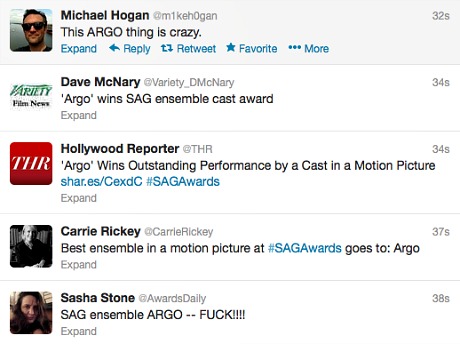Before Ben Affleck‘s Argo won the Producers’ Guild Darryl F. Zanuck award last night, the blogger/columnist view was “the PGA winner won’t be a lock to win the Best Picture Oscar — we all remember Little Miss Sunshine — but a PGA triumph definitely ups the odds and makes an Oscar win very likely.”
After the Argo win (which happened as I was watching the Daniel Day Lewis tribute at Santa Barbara’s Arlington theatre, or a little after 10 pm), the blogger/columnist rumble became “well, uhm…it appears that Lincoln has some stiff competition! Could it be that the our very own, historically-fortified, Spielberg-default, Guru-endorsed Lincoln might actually lose? Well, one thing’s for sure…we have a horse race!”
Lincoln has won no significant Best Picture honors, Argo has won three (PGA, BFCA and Golden Globes), and Silver Linings Playbook is favored to win the Best Ensemble SAG Award at the Shrine Auditorium tonight…and certain blogger/columnists are concluding that Argo might win “but who knows…we have our doubts…the Academy is not the PGA…it has its own way of thinking…could Lincoln snag a win regardless? It’s possible!” (Last night in Santa Barbara a respected columnist conveyed this view in so many words.)
Take the needle out of your arm and listen to the sound of Oscar pollen blowing in the wind. As a Best Picture contender, Lincoln is dead, dead, deader than dead.
Argo is a soft contender, agreed. It doesn’t have anyone’s idea of a strong subtext or thematic undertow. Every since Telluride I’ve been calling it a very well-made caper film — a “secret CIA operation to put one over on the Islamic radicals” movie that is well written, very nicely acted and smoothly assured, that offers a few knowing cracks about film-industry phonies and delivers a satisfying finale in which the baddies are foiled…curses!
So yes, Argo‘s support is not as impassioned as it could be, but the support for Lincoln is even less impassioned. That’s obvious.
The Best Picture contender with the most ardent support is Silver Linings Playbook, or so it’s been observed, but the SLP Hate Brigade has colored the conversation on that film and the longstanding prejudice against Best Picture-ing a comedy or a romcom (despite the fact that SLP is more accurately described as a spirited meds-and-mental-illness dramedy) is as alive as ever.
In my humble view the other “secret CIA plot to put one over on the Islamic radicals and make them angry” film — Zero Dark Thirty — is a sturdier, more impressive achievement. It’s less “commercial,” more finely woven, a stronger dose and obviously more realistic. Compare Argo‘s pure-Hollywood finale at Tehran airport with the cars driving alongside the jet to ZD30‘s Seal attack on the Bin Laden compound in Abottobad. No contest. Three or four months from now Argo will be a Netflix favorite; Zero Dark Thirty will one day be a Criterion Bluray.
But the lazy brains have bought into the leftie-Stalinist bullshit that Kathryn Bigelow‘s film endorses torture, and that’s where the conversation has pretty much stopped.
In my heart of hearts and dream of dreams, Silver Linings Playbook — my emotional favorite of 2012 — pulls out a surprise win. But that’s a dream. Argo will win. It’s pretty much over.
Fair assessment: “Ben Affleck‘s Argo has sealed its comeback from Oscar-nomination disappointment to become the clear frontrunner in the Best Picture race. This year’s best-picture race has been wide open…but wins at the Golden Globes and the Critics’ Choice Movie Awards gave Affleck’s CIA-meets-Hollywood thriller a boost, and the PGA win now edges it past Lincoln and suggests that Argo could well become only the third film to win the top Oscar without a Best Director nomination.” — Steve Pond at TheWrap.
Denial quote #1: “[The PGA win] was the latest triumph for Argo, which won the Golden Globes motion picture-drama earlier in the month. With the win, the film establishes itself firmly as a solid contender for the Best Picture Oscar after earlier being thought out of the running when Ben Affleck was snubbed for best director by the motion picture academy.” — Chris Lee, Julie Makinen, L.A. Times.
“Tentative” Semi-Denial Quote: “It’s starting to get serious. [The PGA] is the first guild to weigh in so we have a tentative frontrunner in Argo now for the Academy Awards’ Best Picture.” — Deadline‘s Pete Hammond.
Even-keeled assessment by Variety‘s Dave McNary: “The PGA winner has matched the Oscar Best Picture winner in the last five years with The Artist, The King’s Speech, The Hurt Locker, Slumdog Millionaire and No Country for Old Men. The PGA and AMPAS last diverged in 2006 when the Zanuck award went to Little Miss Sunshine and The Departed won the Oscar.
“The PGA uses the preferential balloting system employed for the Academy Awards and the PGA winner has matched the Oscar Best Picture in 16 of 23 years. There are 494 producers in the producers branch of the Academy of Motion Picture Arts and Sciences — about 8 percent of the AMPAS membership. “





